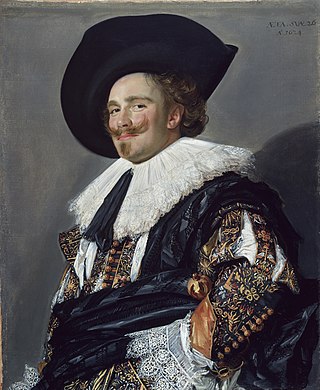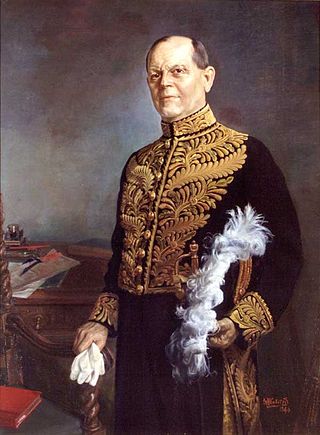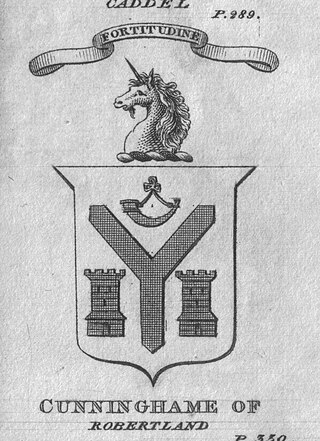Related Research Articles

A doublet is a man's snug-fitting jacket that is shaped and fitted to a man's body. The garment was worn in Spain, and spread to the rest of Western Europe, from the late Middle Ages up to the 17th century. Until the end of the 15th century, the doublet was usually worn under another layer of clothing such as a gown, mantle, or houppelande when in public. In the 16th century it was covered by the jerkin. Women started wearing doublets in the 16th century, and these garments later evolved as the corset and stay. The doublet was thigh length, hip length or waist length and worn over the shirt or drawers.

Fashion in the period 1600–1650 in Western clothing is characterized by the disappearance of the ruff in favour of broad lace or linen collars. Waistlines rose through the period for both men and women. Other notable fashions included full, slashed sleeves and tall or broad hats with brims. For men, hose disappeared in favour of breeches.

Court uniform and dress were required to be worn by those in attendance at the royal court in the 19th and early 20th centuries.

Fashion in the period 1650–1700 in Western clothing is characterized by rapid change. The style of this era is known as Baroque. Following the end of the Thirty Years' War and the Restoration of England's Charles II, military influences in men's clothing were replaced by a brief period of decorative exuberance which then sobered into the coat, waistcoat and breeches costume that would reign for the next century and a half. In the normal cycle of fashion, the broad, high-waisted silhouette of the previous period was replaced by a long, lean line with a low waist for both men and women. This period also marked the rise of the periwig as an essential item of men's fashion.

Clan Cunningham is a Scottish clan. The traditional origins of the clan are placed in the 12th century. However, the first contemporary record of the clan chiefs is in the thirteenth century. The chiefs of the Clan Cunningham supported Robert the Bruce during the Wars of Scottish Independence. In the 15th and 16th centuries, the Clan Cunningham feuded with the Clan Montgomery. Historically, the chief of Clan Cunningham held the title of Earl of Glencairn. However, in modern times the chief of the clan is Cunningham of Corsehill. On 18 December 2013, Sir John Christopher Foggo Montgomery Cunninghame, Baronet of Corsehill, was recognized by Lord Lyon as Clan Chief after the chiefship had been vacant for over 200 years.

Auchenharvie Castle is a ruined castle near Torranyard on the A 736 Glasgow to Irvine road. Burnhouse lies to the north and Irvine to the south. It lies in North Ayrshire, Scotland.

Sir David Cunningham of Robertland, in Ayrshire, was Master of Works to the Crown of Scotland from 1602 to 1607, and Surveyor of the King's Works in England from 1604 to 1606
David Cunningham of Auchenharvie was a Scottish courtier and landowner. An absentee owner of Auchenharvie Castle, in London he was an administrator of royal rents to Charles I of England. A large number of his letters are preserved in the National Records of Scotland.
George Heriot was a Scottish goldsmith and member of the Parliament of Scotland. He is perhaps best known as the father of the philanthropist George Heriot, his eldest son.

The Castle and Barony of Robertland is located near Stewarton, off the B769 road, in the old district of Cunninghame, Parish of Stewarton, and now part of East Ayrshire, Scotland.
Sir David Foulis was a Scottish baronet and politician.
Annabell Murray, Countess of Mar (1536–1603), was a Scottish landowner, courtier and royal servant, the keeper of the infant James VI and his son Prince Henry at Stirling Castle

Jean Stewart, Lady Bargany was a Scottish lady in waiting to Anne of Denmark. She was a younger daughter of Andrew, Master of Ochiltree and Margaret Stewart, Mistress of Ochiltree. Jean was a maiden in the household of Anne of Denmark and her mother was the senior lady in waiting. Her marriage is of special interest to historians.
Robert Jousie was a Scottish textile merchant, financier, and courtier. He was involved in the collection and administration of the English subsidy of James VI.

Queen Elizabeth I of England paid a subsidy to King James VI of Scotland from 1586 to 1602. This enabled her to influence James by delaying or deferring payments to his diplomats in London. Records survive of the yearly amounts, and details of the expenditure in some years. A large proportion of the money was spent on the royal wardrobe of James and Anne of Denmark. Some royal expenses were met by Anne of Denmark's dowry, which was known as the "tocher". The regular incomes of the Scottish crown were feudal rents, customs, and "compositions" charged on grants of land. Accounts for royal incomes and payments survive as the exchequer rolls and lord treasurer's accounts and have been published as historical sources.

Alexander Miller or Millar (1559-1616) was an Edinburgh tailor who served James VI and I.

Peter Sanderson was an Edinburgh tailor who worked for Anne of Denmark wife of James VI of Scotland.

The wardrobe of Mary, Queen of Scots, was described in several contemporary documents, and many records of her costume have been published.

Helen Littil was a Scottish courtier, the nurse of King James VI and I.
Robert Inglis was a merchant and financier of Scottish origin working in London in the first half of the 17th-century.
References
- ↑ Maria Hayward, Stuart Style (Yale, 2020), pp. 182–3, National Records of Scotland GD237/25/2 no. 11.
- ↑ Notes & Queries, 3rd Ser. VI (Nov. 5 1864), p. 371.
- ↑ Archibald Constable, Memoirs of George Heriot (Edinburgh, 1822), p. 177.